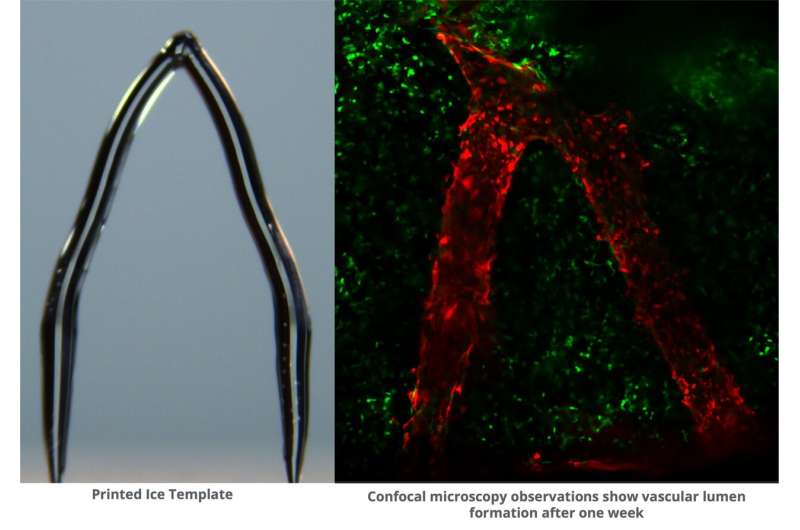This article has been reviewed according to Science X's editorial process and policies. Editors have highlighted the following attributes while ensuring the content's credibility:
fact-checked
trusted source
proofread
New 3D printing method uses ice to build a template for artificial blood vessels in engineered tissue

Over 100,000 individuals in the United States are currently in need of organ transplants. The demand for organs, such as hearts, kidneys, and livers, far exceeds the available supply and people sometimes wait years to receive a donated organ. Approximately 6,000 Americans die while waiting each year.
Tissue engineering to create lab-grown organs and tissues aims to close the gap between the availability of organs and the demand for transplants. But one big challenge in tissue engineering is creating blood vessel networks in artificial organs that work like natural ones, from tiny capillaries to larger arteries. Traditional artificial blood vessel designs often don't mimic the natural design needed to function properly in the body.
However, new research shows the possibility of using 3D ice printing to help create structures that resemble blood vessels in the body. Feimo Yang, a graduate student in the labs of Philip LeDuc and Burak Ozdoganlar at Carnegie Mellon University, present their research at the 68th Biophysical Society Annual Meeting, held February 10–14, 2024 in Philadelphia, Pennsylvania.
3D ice printing generally involves adding a stream of water to a very cold surface. "What makes our method different from other kinds of 3D printing is that instead of letting the water completely freeze while we're printing, we let it maintain a liquid phase on top. This continuous process, which is what we call freeform, helps us to get a very smooth structure. We don't have a layering effect typical with most 3D printing," Yang explained.
They also used heavy water, a form of water where the hydrogen atoms are replaced by deuterium, which gives the water a higher freezing point, and helps create the smooth structure.
These 3D-printed ice templates are then embedded in a gelatin material, GelMA. When exposed to UV light, the gelatin hardens, and the ice melts away, leaving behind realistic blood vessel channels.
The researchers successfully demonstrated that they could introduce endothelial cells, like those in blood vessels, into the fabricated blood vessels. The cells survived on the gelatin for up to two weeks. (In the future, they intend to culture those cells for a longer duration.)
In addition to potential use for organ transplant, Yang points out that 3D printed blood vessels could be used for testing the effects of drugs on blood vessels. They could also be coated with a patient's own cells to see how the cells respond to a drug treatment before giving it to the patient.
This innovative approach could be a significant step forward in creating complex, lifelike blood vessel networks for use in tissue engineering.
Provided by Biophysical Society





















